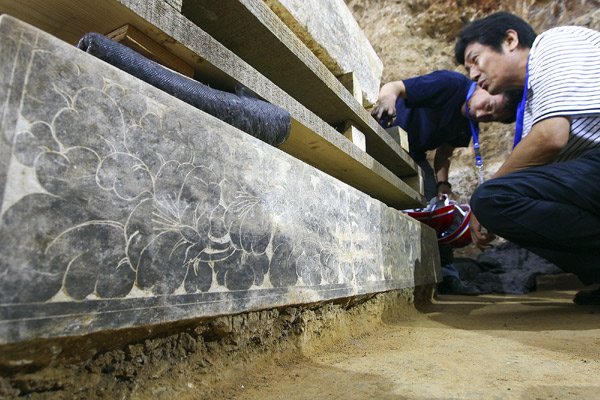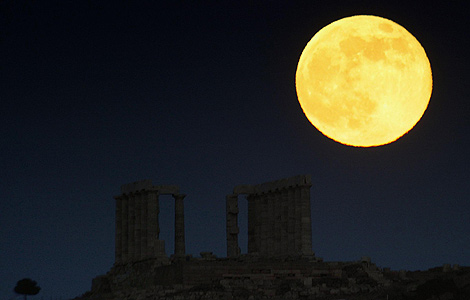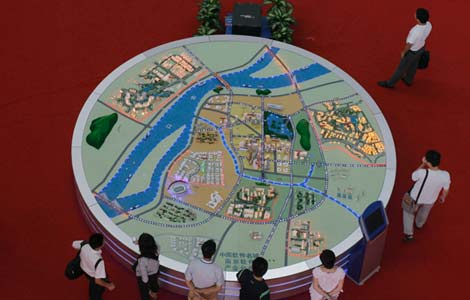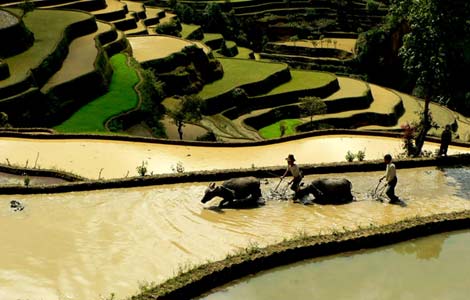Project may be redesigned around tomb
Updated: 2013-06-24 07:13
By Liu Xiangrui (China Daily)
|
||||||||
|
Archaeologists study the cover and base of the inscription stone for the wife of Liu Ji, a major military governor during the Tang Dynasty (AD 618-907). The base has peony patterns. Cheng Gong / for China Daily |
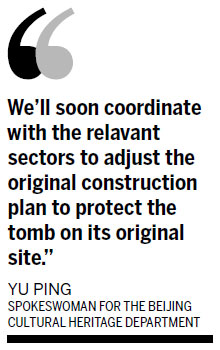
Well-preserved site was resting place of Tang Dynasty military governor, wife
A multibillion yuan construction project in Beijing is likely to be redesigned to protect an important ancient tomb site, which was discovered during a preliminary investigation for the project.
"We'll soon coordinate with the relevant sectors to adjust the original construction plan to protect the tomb on its original site," said Yu Ping, a spokeswoman for the Beijing Cultural Heritage Department.
Yu said she hoped a museum for the tomb would be built and opened to the public in the future.
Because of its large scale and the diverse relics excavated, the tomb is very rare and has high heritage and historical value, said Song Dachuan, director of the Cultural Heritage Research Institute of Beijing. The tomb's main structure has remained basically intact, which is rare among similar archaeological sites, Song added.
The tomb was discovered in 2012 by the local cultural heritage department while they were helping the project planners undertake a preliminary investigation for the "The Cultural Silicon Valley", a large integrated cluster for cultural and creative industries in Changgou town, Fangshan district.
The planned industrial cluster, designed to cover an area of 160 hectares and consisting of 12 smaller projects, had an investment of 13.7 billion yuan ($2.23 billion).
After nearly a year of excavation, relics including delicate frescos, rare inscription stones, pottery, porcelains, bronze, jade and iron pieces have been excavated from the tomb even though it had been raided several times.
The entire structure consists of tomb paths, a tomb gate, a niche, main room, back room and side rooms. The tomb's top was destroyed.
Stone inscriptions confirm the tomb to belong to Liu Ji, a major military governor during the Tang Dynasty (AD 618-907), and his wife.
The inscription stones in the tomb have two layers. The cover on top is inscribed with the tomb owner's name and status, while the lower part records the life and achievements of those interred.
The cover stone for Liu's wife is vividly carved, colorfully depicting people and patterns around the face, with sunken characters decorated with gold in the center. Weighing more than two tons, it is 1.62 meters wide and 0.225 meters high. It is unparalleled by tomb stone inscriptions of the same period ever found in China, Yu said.
"Tang Dynasty tomb inscriptions of such scale are very rare in Beijing."
Through further study of the stone inscriptions, it is possible to learn more about the history of Liu's time, especially the history of Beijing, Yu said.
The base for the coffin is also unusual. It has six layers, which was rare even for emperors. Every layer is carved with patterns such as Buddhist images and lotus flowers.
The excavated pieces will be protected after scientific testing and identification. Among them, the protection of the delicate frescos has posed challenges for archaeologists.
The frescos depict musical performances, daily life, buildings, animals and plants. They provide important material for the study of noble people's lives at that time and in that region, Song said.
Unlike those uncovered in other regions, the frescos are painted on the walls without any underlayer, Song said.
Archaeologists said they would not rule out the possibility of stopping the excavation temporarily until they find an ideal way to prevent the pictures from oxidation.
Experts also need more clues to explain strange things found during the excavation, such as why the bones of Liu's wife are missing and why the tomb inscription for her is more extravagant than for her husband, which was rare according to the feudal customs of the time.
Only a male skull was found in the joint burial tomb. Song said it will take further tests to confirm whether the skull belonged to Liu.
"The questions remain to be answered with later research. The results will be released to the public as soon as possible," Yu said.
Related readings:
Developers raze ancient tombs
Police smash tomb-robbing gang in N China
20 ancient tombs unearthed in SW China
Suspected tomb of Chinese tyrant discovered
Famous emperor's tomb found in Yangzhou
Ancient tomb raided hours after it was discovered
Most Viewed
Editor's Picks
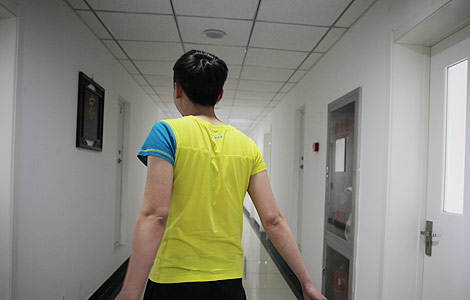
|
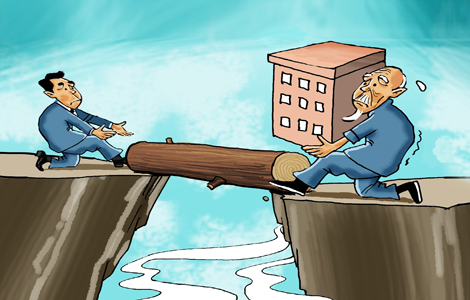
|

|

|

|

|
Today's Top News
Spacecraft completes manual docking
US 'stole' China's statistics
Mandela's condition critical
Suspect in shooting spree detained
Mountaineers killed in Pakistan
Foreign firms eye new 'opening-up'
Project halted due to bird nests
Man gets death for killing 7 in 9 days
US Weekly

|

|
